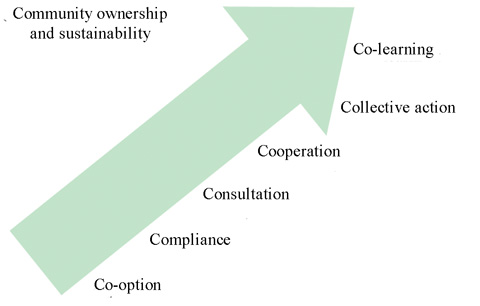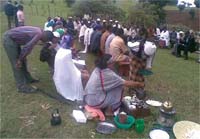Levels of community participation
All participation is not equal. The extent of participation in programmes can vary from minimal to complete ownership. Figure 19.9 shows increasing degrees of participation from the low end of co-option to the upper end of collective action. This shows that as community participation increases, community ownership and capacity increases. Box 19.4 defines different degrees of community participation.

Figure 19.9 Community ownership and sustainability.

Figure 19.10 The resources of the whole community will be used if community mobilisation is successful. (Photo: Last Ten Kilometres Project)
Box 19.4 Degrees of community participation
- Co-option: Local representatives are chosen, but have no real input or power.
- Compliance: Tasks are assigned with incentives, but outsiders decide the agenda and direct the process.
- Consultation: Local opinions are asked for, and outsiders analyse and decide on a course of action.
- Cooperation: Local people work together with outsiders to determine realities; responsibility remains with outsiders for directing the process.
- Collective action: Local people set their own agenda and mobilise to carry it out, in the absence of outside initiators and facilitators (Figure 19.10).
- Co-learning: Local people and outsiders share their knowledge to create a new understanding, and work together to form action plans, with outsiders facilitating.
There are different tools to help the community to participate effectively. Two of the commonly used participatory tools are community mapping and community conversation.
Last modified: Saturday, 28 June 2014, 8:58 PM